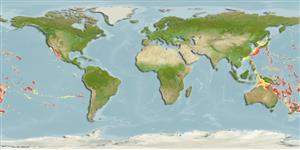Articulata |
Terebratulida |
Thecidellinidae | Thecidellininae
Environment: milieu / climate zone / depth range / distribution range
Ecology
Benthic; depth range 3 - 1158 m (Ref. 97604). Tropical
Indo-Pacific.
Length at first maturity / Size / Weight / Age
Maturity: Lm ? range ? - ? cm
Minimum depth from Ref. 106682. Found in shaded overhangs and submarine caves (Ref. 82739), in subtidal areas attached to coral rubble (Ref. 106682). Filter-feeder (Ref. 68823).
Life cycle and mating behavior
Maturity | Reproduction | Spawning | Eggs | Fecundity | Larvae
Members of the phylum Brachiopoda are gonochoric. Eggs are shed into the water and fertilized at the time of spawning. Life cycle: Eggs develop into free-swimming larvae which later metamorphose into adult.
Andrew, N. and M. Francis 2003 The living reef. The ecology of New Zealand's rocky reefs. Craig Potton Publishing, New Zealand. 283pp. (Ref. 82739)
IUCN Red List Status
(Ref. 130435: Version 2025-1)
CITES status (Ref. 108899)
Not Evaluated
Not Evaluated
Threat to humans
Harmless
Human uses
| FishSource |
Tools
More information
Trophic EcologyFood items (preys)
Diet composition
Food consumption
Predators
Population dynamicsGrowth
Max. ages / sizes
Length-weight rel.
Length-length rel.
Length-frequencies
Mass conversion
Abundance
Life cycleReproductionMaturityFecunditySpawningEggsEgg developmentLarvae PhysiologyOxygen consumption
Human RelatedStamps, coins, misc.
Internet sources
Estimates based on models
Preferred temperature
(Ref.
115969): 8.7 - 18.7, mean 13.3 (based on 72 cells).
